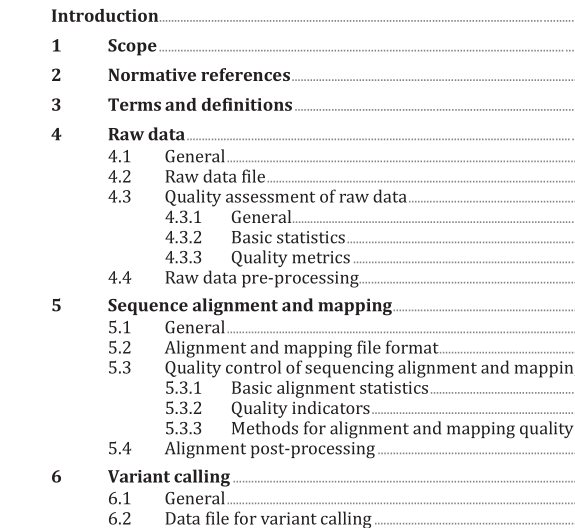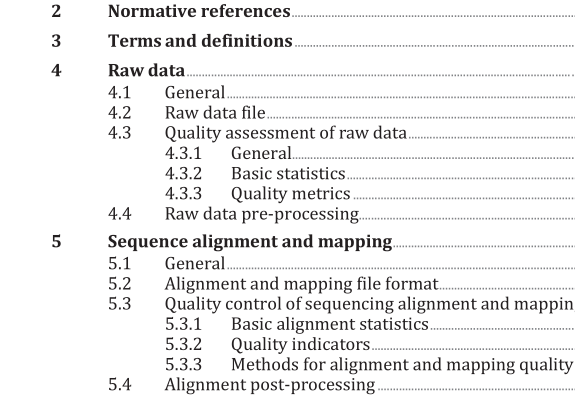ISO 20397-2:2021 pdf download – Biotechnology — Massively parallel sequencing — Part 2: Quality evaluation of sequencing data.
3.13 deletion loss of one (or more) nucleotide base pair(s) from a nucleic acid sequence compared to its reference sequence 3.14 duplication level number of identical repeats for every sequence in a library Note 1 to entry: The duplication level is usually displayed in a plot showing the relative number of sequences with different degrees of duplication. 3.15 GC content percentage of guanine and cytosine in one or more nucleic acid sequence(s) Note 1 to entry: The amount of guanine and cytosine in a polynucleic acid, is usually expressed in mole fraction (or percentage) of total nitrogenous bases. Total nitrogenous bases comprise the total number of nucleotide bases of reads from one or more MPS run. 3.16 gene sequence of nucleotides in DNA or RNA encoding either an RNA or a protein product Note 1 to entry: Genes are recognized as the basic unit of heredity. Note 2 to entry: A gene can consist of non-contiguous nucleic acid segments that are rearranged through a nuclear processing step. Note 3 to entry: A gene may include or be part of an operon that includes elements for gene expression. 3.17 indel insertion (3.18) or /and deletion (3.13) of nucleotides in genomic DNA Note 1 to entry: Indels are less than 1 000 bases in length. 3.18 insertion addition of one (or more) nucleotide base pair(s) into a nucleic acid sequence [SOURCE: ISO/TS 20428: 2017, 3.19, modified — DNA was replaced by nucleic acid.] 3.19 sequencing determining the order and the content of nucleotide bases (adenine, guanine, cytosine, thymine, and uracil) of a nucleic acid molecule Note 1 to entry: A sequence is generally described from the 5’ to 3’ end. [SOURCE: ISO/TS 17822-1:2020, 3.19, modified — DNA was deleted in the term; DNA was replaced by nucleic acid, and uracil was added in the definition.] 3.20 sequence alignment arrangement of nucleic acid sequences according to regions of similarity Note 1 to entry: Sequence alignment may not require a reference genome /reference targeted nucleic acid region and its aim might not produce an assembly.
3.21 raw data primary sequencing data produced by a sequencer without involving any software-based pre-filtering for analysis purpose 3.22 RNA ribonucleic acid polymer of ribonucleotides occurring in a double-stranded or single-stranded form Note 1 to entry: Synthesis of proteins in cells is directed by genetic information carried in the sequence of nucleotides in a class of RNA known as messenger RNA (mRNA). 3.23 ribonucleotide nucleotide containing ribose as its pentose component forming the basic building blocks for RNA Note 1 to entry: The ribonucleotides consist of adenylate (AMP), guanylate (GMP), cytidylate (CMP), or uridylate (UMP). 3.24 read sequence read nucleotide sequence generated by a sequencing device Note 1 to entry: A read is a deduced sequence of nucleic acid base pairs (or base pairs probabilities) corresponding to all (or part of) a single nucleic acid fragment. Read can be used to refer to as those sequences obtained from MPS experiments.
ISO 20397-2:2021 pdf download – Biotechnology — Massively parallel sequencing — Part 2: Quality evaluation of sequencing data






